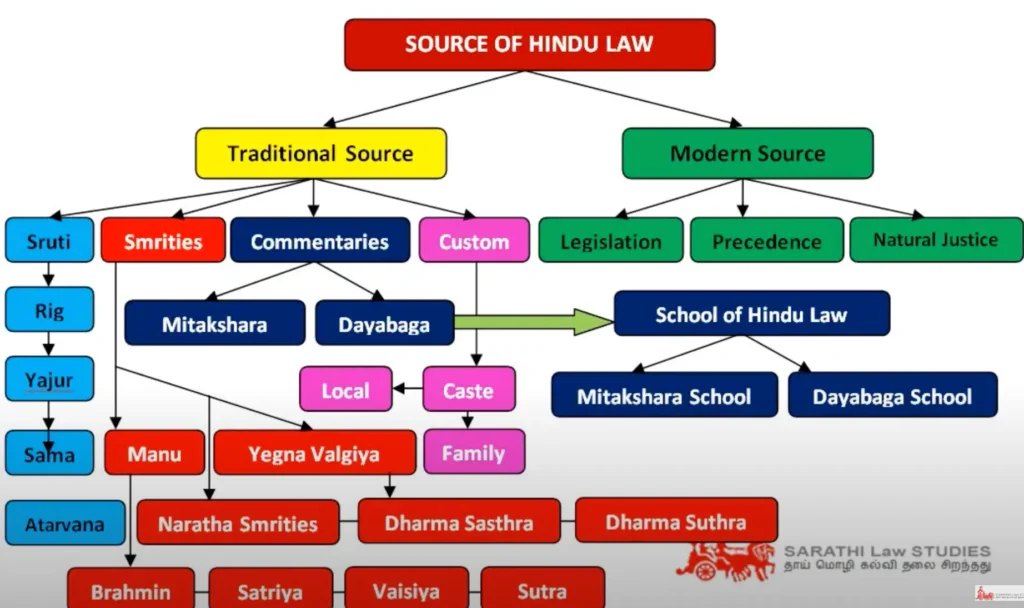Introduction
Hindu law is one of the oldest systems of jurisprudence in the world, with its roots deeply embedded in India’s ancient civilization. This guide explores the sources and schools of Hindu law, tracing its historical origins and modern-day evolution.
Whether you are a law student, researcher, or enthusiast, understanding the foundations of Hindu law provides valuable insights into its principles, relevance, and application.
Understanding the Sources of Hindu Law
The sources of Hindu law can be broadly categorized into Ancient and Modern sources. These sources have shaped the legal framework governing Hindu society for centuries.

Image Credit: https://youtu.be/GZAsOnvhDWI?feature=shared
1. Ancient Sources of Hindu Law
Shrutis (Divine Revelations)
Shruti, meaning “that which is heard,” refers to the divine revelations that form the foundation of Hindu law. The Vedas (Rigveda, Yajurveda, Samaveda, and Atharvaveda) and the Upanishads are considered the ultimate source of legal and moral guidance. These texts are believed to have been revealed to sages and form the core of the Hindu legal tradition.
Smritis (Memorized Texts):
Smriti means “what is remembered.” Unlike Shrutis, which are considered divine and without authorship, Smritis are authored texts. Notable Smritis include:
1. Manu Smriti: The oldest and most influential Smriti, focusing on caste duties and societal norms.
2. Yajnavalkya Smriti: A more liberal Smriti that recognized some rights for women and Shudras.
3. Narada Smriti: A progressive text that introduced concepts like widow remarriage and the supremacy of royal law over religious texts.
Commentaries and Digests:
As time passed, commentators like Mitakshara and Dayabhaga reconciled contradictions in the Smritis and clarified the application of Hindu law. These commentaries played a pivotal role in shaping the two major schools of Hindu law.
Customs
Customary law (achara) has always been an essential source of Hindu law. Customs reflect societal practices and carry the force of law when they are ancient, reasonable, and continuously followed.
Key judgments, such as Deivanai Achi v. Chidambaram, emphasized that valid customs must not contradict public policy.
Also Read: Section 13 of the Hindu Marriage Act, 1955: A Comprehensive Guide
2. Modern Sources of Hindu Law
Judicial Decisions:
Under the British colonial rule, judicial decisions became an integral part of Hindu law. Courts often relied on commentaries and Smritis while adding their interpretations. Over time, judicial precedents gained equal authority as religious texts.
The Doctrine of Precedent established the importance of past judicial decisions in shaping modern Hindu law.
Legislative Enactments:
In post-independence India, various laws reformed and standardized Hindu law. Key legislations include:
- Hindu Marriage Act, 1955
- Hindu Succession Act, 1956
- Hindu Adoptions and Maintenance Act, 1956
These Acts modernized traditional Hindu law, promoting gender equality, inheritance rights, and marriage reforms.
Equity, Justice, and Good Conscience:
In situations where no clear law existed, courts applied the principles of equity, justice, and good conscience.
This approach ensures that laws are interpreted reasonably and justly, as seen in landmark cases like Gurunath v. Kamlabai.
The Major Schools of Hindu Law
Two major schools of Hindu law emerged due to differences in interpretations of Smritis and commentaries:
1. Mitakshara School
This school is primarily followed in most parts of India. It advocates joint family ownership of property, where ancestral property is inherited at birth. The Mitakshara school emphasizes family unity and shared responsibility.
2. Dayabhaga School
Mainly practiced in Bengal and Assam, the Dayabhaga school promotes individual ownership of property, with inheritance occurring only after the owner’s death. It allows more flexibility and personal control over property compared to the Mitakshara system.
The Modern Influence of Hindu Law
Hindu law has evolved significantly, maintaining its core principles while adapting to contemporary society. Modern legislation, judicial decisions, and international human rights movements have ensured that Hindu law aligns with modern notions of justice, equity, and individual rights.
Frequently Asked Questions (FAQs)
1. What are the main sources of Hindu law?
Hindu law draws from both ancient and modern sources. Ancient sources include Shrutis (Vedas and Upanishads), Smritis (Manu, Yajnavalkya, Narada), commentaries, and customs. Modern sources include judicial decisions, legislative enactments, and equity, justice, and good conscience.
2. How do the Mitakshara and Dayabhaga schools differ?
The Mitakshara school emphasizes joint family ownership of property and inheritance by birth. In contrast, the Dayabhaga school focuses on individual property ownership and inheritance only after the owner’s death, offering more autonomy to individuals.
3. How has modern legislation impacted Hindu law?
Modern legislation has reformed Hindu law by addressing issues like gender equality, inheritance rights, and marriage reforms. Key Acts, such as the Hindu Marriage Act, 1955, and the Hindu Succession Act, 1956, have significantly shaped the legal landscape for Hindus in India.